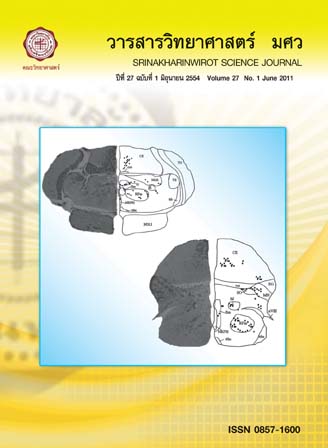การแยกแบคทีเรียกรดแลคติกและเฟจของแบคทีเรียกรดแลคติกจากผลิตภัณฑ์อาหารปลาหมักของไทย
Keywords:
แลบเฟจ แบคทีเรียกรดแลคติก ผลิตภัณฑ์อาหารปลาหมัก การแยก การศึกษาลักษณะLAB phage, lactic acid-producing bacteria, fermented fish products, isolation, characterizationAbstract
จากการแยกแบคทีเรียกรดแลคติกและแลบเฟจจากตัวอย่างผลิตภัณฑ์อาหารปลาหมักในประเทศไทยทั้งหมด 51 ตัวอย่าง สามารถแยกแบคทีเรียกรดแลคติกได้ทั้งหมด 60 ไอโซเลท เมื่อนำแบคทีเรียกรดแลคติกทั้งหมดมาแยกแลบเฟจพบว่า สามารถแยกแลบเฟจได้ 4 ตัว คือ F-42, F-50, F-57 และ F-59 ซึ่งโฮสท์ของเฟจเหล่านี้ คือ แบคทีเรีย F42, F50, F57 และ F59 เมื่อทำการจัดจำแนกแบคทีเรียกรดแลคติกที่ใช้เป็นโฮสท์ของเฟจดังกล่าว โดยการเปรียบเทียบลำดับเบสบริเวณ 16S rDNA ของโฮสท์กับฐานข้อมูล GenBank พบว่าโฮสท์ F42 มีความคล้ายคลึงกับ Leuconostoc lactis (GenBank accession number GU125559) ร้อยละ 100 โฮสท์ F50 มีความคล้ายคลึงกับ Leuconostoc mesenteroides subsp. mesenteroides (GenBank accession number GU138559) ร้อยละ 99 โฮสท์ F57 และ F59 มีความคล้ายคลึงกับ Weissella cibaria (GenBank accession number AB494716) ร้อยละ 100 สำหรับลักษณะทั่วไปของเฟจทั้ง 4 ตัว พบว่าสามารถทำลายแบคทีเรีย ก่อให้เกิดวงใส (พลาค) จึงจัดเป็นไวรูเรนท์เฟจ และเมื่อศึกษารูปร่างภายใต้กล้องจุลทรรศน์อิเล็กตรอนแบบส่องผ่าน พบว่าสามารถแยกออกได้เป็น 2 แฟมิลี โดยเฟจ F-42 และเฟจ F-50 มีส่วนหัวเป็นรูปหกเหลี่ยมขนาดเส้นผ่านศูนย์กลาง 82 และ 64 นาโนเมตร ตามลำดับ และส่วนหางยาวไม่สามารถยืดหดได้ ขนาดความยาว 182 และ 327 นาโนเมตร ตามลำดับ ดังนั้นจึงจัดจำแนกเฟจนี้อยู่ในแฟมิลี Siphoviridae ส่วนเฟจ F-57 และ F-59 มีส่วนหัวเป็นรูปหกเหลี่ยมขนาดเส้นผ่านศูนย์กลาง 94 x 44 และ 96 x 43 นาโนเมตร ตามลำดับ และส่วนหางสั้นไม่สามารถยืดหดได้ ขนาดความยาว 31และ 23 นาโนเมตร ตามลำดับ จึงจัดอยู่ในแฟมิลี Podoviridae เมื่อนำมาศึกษาโฮสท์ - เรนจ์ พบว่า แลบเฟจเหล่านี้ไม่สามารถทำให้เกิดการติดเชื้อกับแบคทีเรียกรดแลคติกสายพันธุ์อื่นและจีนัสอื่นที่นำมาทดสอบได้ ยกเว้นเฟจ F-59 ที่สามารถทำให้เกิดการติดเชื้อกับ Weissella cibaria N22 ที่นำมาทดสอบได้ และเมื่อสกัดดีเอ็นเอของเฟจแล้วนำมาตัดด้วยเอนไซม์ตัดจำเพาะ พบว่าเฟจทั้ง 4 ตัวมีรูปแบบของดีเอ็นเอหลังจากตัดด้วยเอนไซม์ต่างกัน จึงยืนยันได้ว่าเป็นแลบเฟจต่างชนิดกัน นอกจากนี้ยังพบว่าไดวาเลนท์แคทไอออน 2 ชนิด (CaCl2 และ MgCl2) ไม่มีผลต่อการเข้าเกาะติดโฮสท์ของแลบเฟจ งานวิจัยนี้บ่งชี้ว่าแลบเฟจหลายชนิดสามารถถูกแยกได้จากผลิตภัณฑ์อาหารปลาหมัก ซึ่งการวิเคราะห์ทางสัณฐานวิทยาและชีวโมเลกุลสามารถแสดงให้เห็นถึงลักษณะจำเพาะของแลบเฟจนั้นๆ ได้ Lactic acid bacteria (LAB) and their phages were isolated from Thai fermented fish products. From 51 of Thai fermented fish products, 60 isolates of LAB were obtained and employed as hosts for isolation of phages. There were four different phages, named as F-42, F-50, F-57 and F-59, which were isolated using four distinctive bacterial hosts, so-called F42, F50, F57 and F59. These LAB were identified by 16S rDNA sequence analysis, and BLAST searches against the GenBank database revealed that F42 possessed 100% similarity to Leuconostoc lactis (GenBank accession number GU125559), F50 possessed 99% similarity to Leuconostoc mesenteroides subsp. mesenteroides (GenBank accession number GU138559), and F57 and F59 were found to be Weissella cibaria (GenBank accession number AB494716) with 100% similarities. All phages of these LAB produced clear plaques, thus indicating their virulent characteristics. Electron micrographs revealed that these four phages belonged to two morphological families. Phages F-42 and F-50 were found to have hexagonal heads (82 nm and 64 nm in diameter, respectively) and long noncontractile tails (182 nm and 327 nm in length, respectively), indicating that they belonged to Siphoviridae family. Moreover, phages F-57 and F-59 were shown to have hexagonal heads (94 x 44 nm and 96 x 43 nm in diameter, respectively) and short noncontractile tails (31 nm and 23 nm in length, respectively), suggesting that they belonged to Podoviridae family. The host-range determination revealed that these phages were incapable of cross-infection, with the exception of F-59 which was able to infect the tested Weissella cibaria N22. In addition, the DNA isolated from these four phages were characterized using restriction enzyme analysis which showed that the restriction fragments of F-42, F-50, F-57 and F-59 phages were different. Furthermore, the presence of divalent cations (CaCl2 and MgCl2) was not found to affect phage adsorption. This study showed that a variety of LAB phages could be isolated from fermented fish products and morphological and molecular characterizations suggested their distinctive properties.Downloads
Download data is not yet available.
Downloads
Published
2011-06-11
How to Cite
จันทร์ทัง พ., พริ้งศุลกะ อ., สุวรรณาศรัย ณ., สุขสวัสดิ์ พ., & รังษิรุจิ อ. (2011). การแยกแบคทีเรียกรดแลคติกและเฟจของแบคทีเรียกรดแลคติกจากผลิตภัณฑ์อาหารปลาหมักของไทย. Science Essence Journal, 27(1). Retrieved from https://ejournals.swu.ac.th/index.php/sej/article/view/1457
Issue
Section
Research Article








